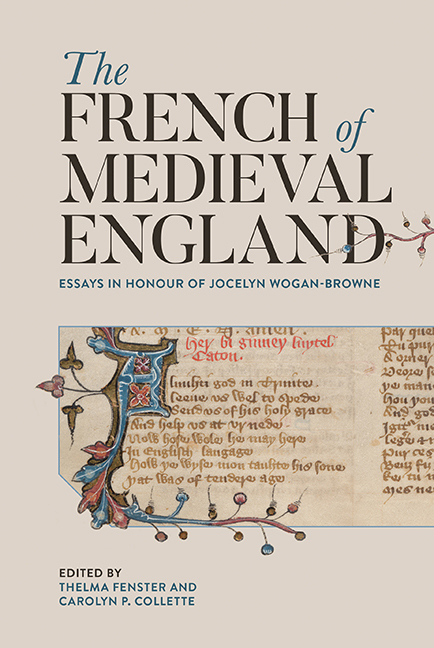Book contents
- Frontmatter
- Contents
- List of Illustrations
- List of Contributors
- List of Abbreviations
- Foreword: ‘The Light I Never Left Behind’: Jocelyn Wogan-Browne
- Introduction: Recognizing the French of Medieval England
- 1 The Gloss to Philippe de Thaon's Comput and the French of England's Beginnings
- 2 The Scandals of Medieval Translation: Thinking Difference in Francophone Texts and Manuscripts
- 3 Contrafacture and Translation: The Prisoner's Lament
- 4 Complaining about the King in French in Thomas Wright's Political Songs of England
- 5 The Chanson d’Aspremont in Bodmer 11 and Plantagenet Propaganda
- 6 The Use of Anglo-Norman in Day-to-Day Communication during the Anglo-Scottish Wars (1295–1314)
- 7 Middle English Borrowing from French: Nouns and Verbs of Interpersonal Cognition in the Early South English Legendary
- 8 William Langland Reads Robert Grosseteste
- 9 Disability Networks in the Campsey Manuscript
- 10 English Women and Their French Books: Teaching about the Jews in Medieval England
- 11 French Residents in England at the Start of the Hundred Years War: Learning English, Speaking English and Becoming English in 1346
- 12 French Immigrants and the French Language in Late-Medieval England
- 13 Fashioning a Useable Linguistic Past: The French of Medieval England and the Invention of a National Vernacular in Early Modern France
- 14 Admiring Ambivalence: on Paul Meyer's Anglo-Norman Scholarship
- 15 Twenty-First Century Gower: The Theology of Marriage in John Gower's Traitié and the Turn toward French
- 16 Royaumes sans frontières: The Place of England in the Long Twelfth Century
- Afterword
- Bibliography
- Index
- Publications of Jocelyn Wogan-Browne
- Tabula Gratulatoria
1 - The Gloss to Philippe de Thaon's Comput and the French of England's Beginnings
Published online by Cambridge University Press: 12 August 2020
- Frontmatter
- Contents
- List of Illustrations
- List of Contributors
- List of Abbreviations
- Foreword: ‘The Light I Never Left Behind’: Jocelyn Wogan-Browne
- Introduction: Recognizing the French of Medieval England
- 1 The Gloss to Philippe de Thaon's Comput and the French of England's Beginnings
- 2 The Scandals of Medieval Translation: Thinking Difference in Francophone Texts and Manuscripts
- 3 Contrafacture and Translation: The Prisoner's Lament
- 4 Complaining about the King in French in Thomas Wright's Political Songs of England
- 5 The Chanson d’Aspremont in Bodmer 11 and Plantagenet Propaganda
- 6 The Use of Anglo-Norman in Day-to-Day Communication during the Anglo-Scottish Wars (1295–1314)
- 7 Middle English Borrowing from French: Nouns and Verbs of Interpersonal Cognition in the Early South English Legendary
- 8 William Langland Reads Robert Grosseteste
- 9 Disability Networks in the Campsey Manuscript
- 10 English Women and Their French Books: Teaching about the Jews in Medieval England
- 11 French Residents in England at the Start of the Hundred Years War: Learning English, Speaking English and Becoming English in 1346
- 12 French Immigrants and the French Language in Late-Medieval England
- 13 Fashioning a Useable Linguistic Past: The French of Medieval England and the Invention of a National Vernacular in Early Modern France
- 14 Admiring Ambivalence: on Paul Meyer's Anglo-Norman Scholarship
- 15 Twenty-First Century Gower: The Theology of Marriage in John Gower's Traitié and the Turn toward French
- 16 Royaumes sans frontières: The Place of England in the Long Twelfth Century
- Afterword
- Bibliography
- Index
- Publications of Jocelyn Wogan-Browne
- Tabula Gratulatoria
Summary
Among the many subjects Jocelyn Wogan-Browne has touched in her career thus far, the French of England has been molded by her most of all. In her honor, this chapter explores the implications of one manuscript of Le Comput by Philippe de Thaon for our understanding of where the French of England came from, how it was first received and what it had to do with earlier written English. An incredible six whole or partial copies of Le Comput survive from the twelfth century, more than any other text except the various French-language versions of the Psalter. It would be rash to call Le Comput the most popular original French-language work of the twelfth century, but certainly it epitomized, along with the French Psalter, the kind of text that scribes frequently committed to parchment and later readers preserved. As such it possesses a remarkable but largely unexplored importance in the history of written French.
Cambridge, University Library, MS Additional 4166, Fragment 9, is our earliest witness to Philippe's text and contains a fragmentary copy of Le Comput, glossed in Latin. Long considered to be from the late twelfth or early thirteenth century, the manuscript was reassigned to the first half of the twelfth century by Maria Careri, Christine Ruby and Ian Short in their Livres et écritures en français et en occitan au XIIe siècle: catalogue illustré. That revision makes the Cambridge fragment one of only seven surviving French-language manuscripts produced in England before the middle of the twelfth century and a unique example of an extensive Latin gloss on a French-language manuscript before 1200.
The Cambridge fragment's peculiar layout, where Latin glosses French and not the other way around, invites us to rethink the relationship between different languages in Philippe's writing and to broaden our critical conceptions of the meaning of the romance vernacular in the first half of the twelfth century. Frameworks that explain language choice by means of the prestige or inherent authority of one language vis-à-vis another cannot explain the form of the Cambridge fragment or the content and style of Le Comput as a whole.
- Type
- Chapter
- Information
- The French of Medieval EnglandEssays in Honour of Jocelyn Wogan-Browne, pp. 13 - 37Publisher: Boydell & BrewerPrint publication year: 2017
- 1
- Cited by



